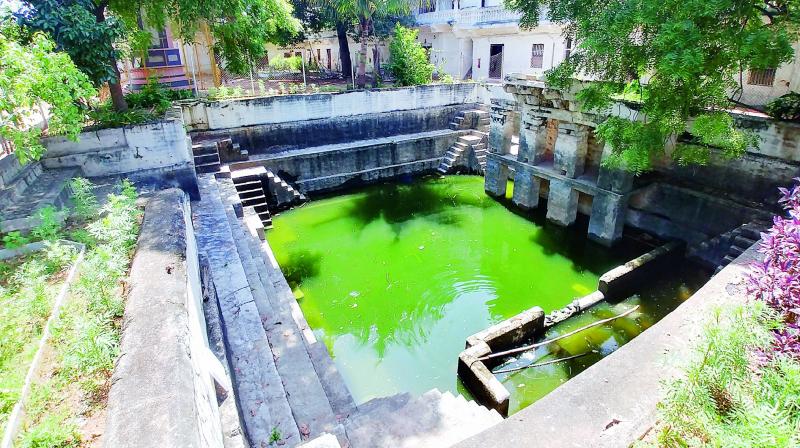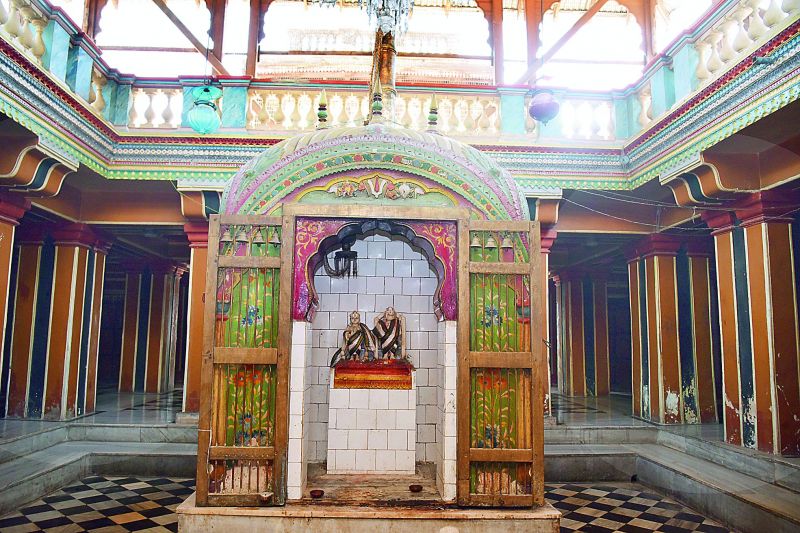Hyderabad: Walls, wells around Sitarambagh temple
The Sitarambagh temple has a shrine dedicated to Lord Hanuman.

Hyderabad: The Sitarambagh temple is built over 25 acres and has a 50-feet wall, giving the temple a fort like look. In these days and times, it keeps the encroachers out, but there was a time when it protected Hindu women from Razakars. That is the time 10,000 Hindu women took shelter at the temple. “We protected them and the food was supplied at the temple,” says Arvind Ganeriwal.
The temple is equipped with six step wells of which one is defunct. Not surprisingly, there are three mosques around the temple. The property includes an old Qutub Shahi mosque with a step well, near which Puranmalji constructed the temple complex.
The Ganga-Jamni tehzeeb for which Hyderabad is still famous must have existed till the Razakar movement, for, presumably, after that a wall was built to separate the mosque from the temple, though both of them still use the water from the same stepwell.
Repair uncovers full Hanuman idol
The Sitarambagh temple has a shrine dedicated to Lord Hanuman. The vigraha (idol) that you see now is a discovery even for the family members.
“We had been worshipping Hanuman only till the knee,” said Arvindji, “not knowing that the rest had been buried over a period of time.”
 The deities Garuda and Hanuman at a shrine in front of the dhwaja stambham. (Photo: DC)
The deities Garuda and Hanuman at a shrine in front of the dhwaja stambham. (Photo: DC)
“When we were doing Jirnodhar (renovation), we had to work on it carefully. There were sentiments and we could not use a hammer or a chisel,” said Arvindji. They used a decoction of soap nuts, buttermilk, curds, rice water and multani mitti and bathed the statue with this till all the pigmentation that had formed over the statue was washed.
One day, a worker in his haste poured the entire decoction into a crack. That is when they finally saw the magnificent idol of Hanuman that was was 6.5 feet tall, 4 feet wide and 3.5 feet thick.
Family had strong ties with the nizam
Puranmalji Ghaneriwal came from Ghaneri village in Rajasthan, about 250 km from Ajmer. It is now known for money lending, but those days it was barter system and he came to the Nizam’s dominion in Hyderabad to earn money.
Once when Puranmalji was waiting to call on the Nizam, one of the ladies from the harem, apparently from his village, spotted him and took him to the Nizam. And thus Puranmalji got involved in the finances of the Nizam.
The Nizam’s kingdom was extensive and the Maratha kings were not paying their share of revenue.
Puranmalji sent his son Prem Sundar to do the needful. It is said that he collected the revenue and came back with 100 cartloads of coins. The Nizam, ever grateful, gave them a jagir (granting feudal land), but Puranmalji had foresight and realised that a Hindu could not take donation or even jagir from a Muslim.
So they built a chabutra, a paved terrace, where the then Nizam came and they organised a little function for him and offered nazrana.
The Nizam in return gave the jagir to Puranmalji. The revenue of two villages in Berar (now in Vidharbha) was granted to take care of the running expenses of the temple.
Dr Arvind Kumar Ganeriwal, is a seventh generation descendent of Puranmalji and lives in the temple premises. His brother Ananth Prasad Ganeriwal looks after the Rangji temple in Pushkar, Rajasthan.

